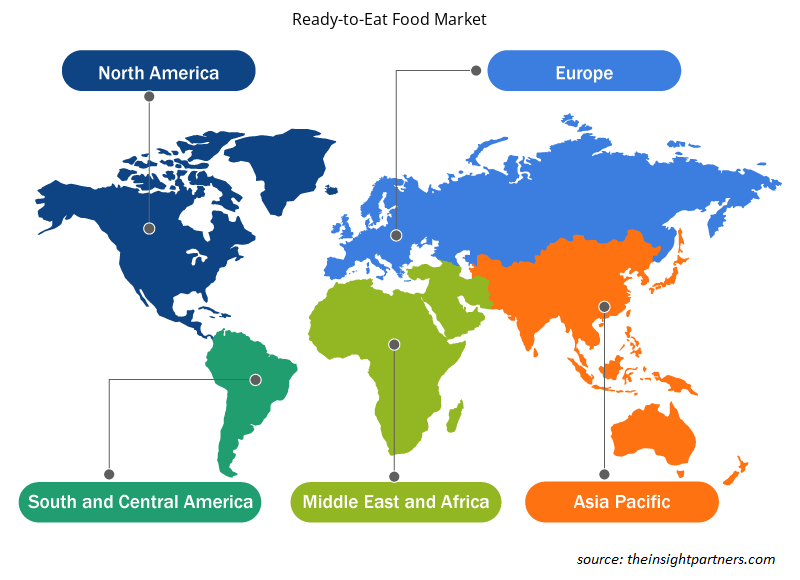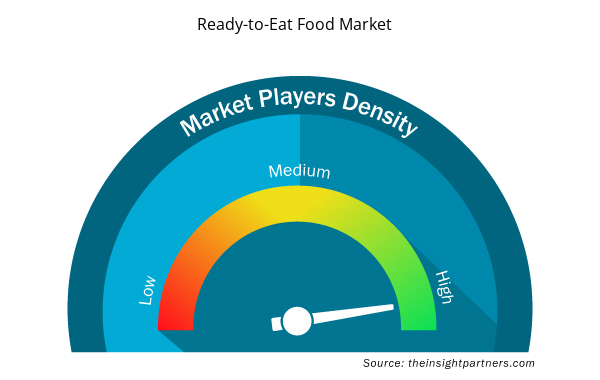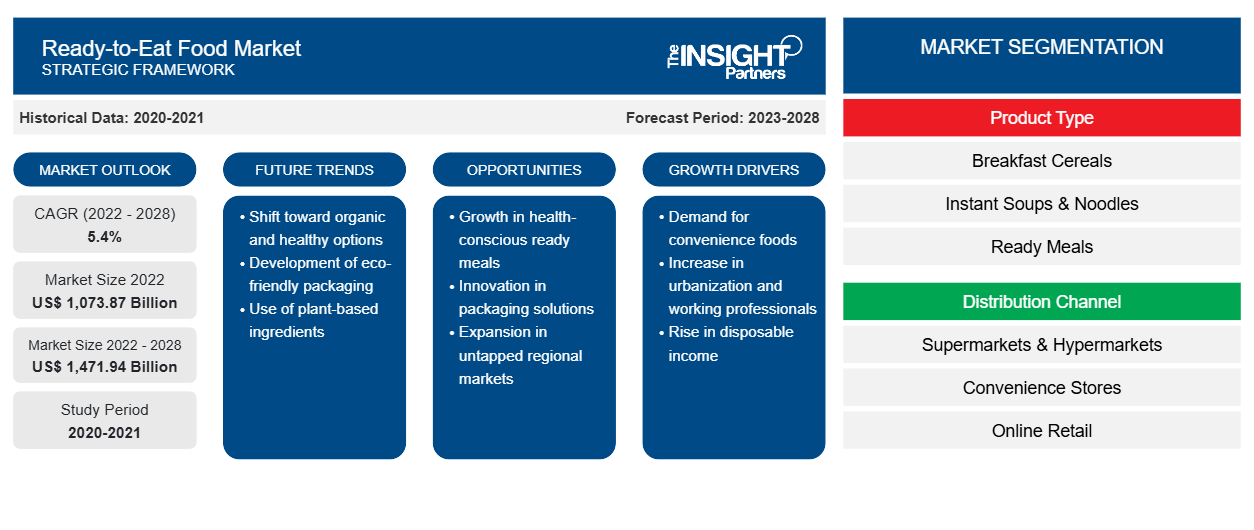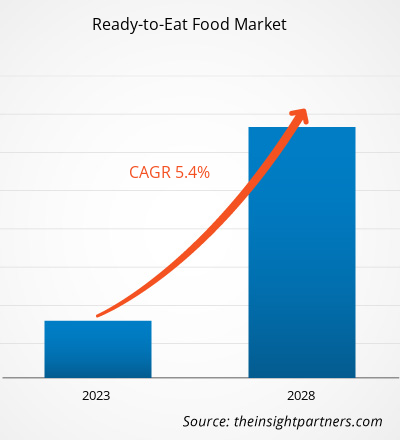[Rapporto di ricerca] Si prevede che il mercato degli alimenti pronti al consumo raggiungerà 1.471,94 miliardi di dollari entro il 2028, rispetto ai 1.073,87 miliardi di dollari del 2022. Si prevede che crescerà a un CAGR del 5,4% dal 2022 al 2028.
Il cibo pronto al consumo è costituito da vari alimenti trasformati e confezionati che possono essere consumati senza ulteriore preparazione. Gli ingredienti vengono lavati, cotti, trasformati e confezionati in contenitori per il consumo diretto. Alcuni tipi comuni di alimenti RTE includono zuppe istantanee, prodotti da forno, dessert e pasti pronti. Questi prodotti sono arricchiti con vari estratti, acidi, aromi, dolcificanti , antiossidanti e conservanti. Offrono un'immensa praticità al consumatore, aiutando nel contempo a ridurre i tempi di preparazione dei pasti e a garantire una maggiore durata di conservazione dei prodotti, un'efficienza dei costi e un deterioramento minimo.
L'Asia Pacifica ha detenuto la quota maggiore del mercato degli alimenti pronti al consumo nel 2020, mentre altre regioni in via di sviluppo, come Medio Oriente e Africa, dovrebbero crescere in modo significativo nel periodo di previsione. I principali attori che operano nel mercato degli alimenti pronti al consumo stanno espandendo le loro attività in tutta l'Asia Pacifica a causa dell'aumento della popolazione attiva e degli stili di vita frenetici delle persone nei paesi in via di sviluppo. Gli individui stanno sempre più optando per il consumo di cibo in movimento o fuori casa.
Inoltre, numerosi studi hanno stabilito che le multinazionali del cibo e delle bevande (TFBC) hanno plasmato i sistemi alimentari e il consumo generale in modi che cambiano la disponibilità, la desiderabilità, il prezzo e, in ultima analisi, il consumo di alimenti trasformati. La crescita del mercato degli alimenti pronti al consumo è stata osservata in modo evidente nei paesi a medio reddito.
Personalizza questo report in base alle tue esigenze
Riceverai la personalizzazione gratuita di qualsiasi report, comprese parti di questo report, o analisi a livello nazionale, pacchetto dati Excel, oltre a usufruire di grandi offerte e sconti per start-up e università
- Scopri le principali tendenze di mercato in questo rapporto.Questo campione GRATUITO includerà analisi di dati che spaziano dalle tendenze di mercato alle stime e alle previsioni.
Impatto della pandemia di COVID-19 sul mercato degli alimenti pronti al consumo
La pandemia di COVID-19 ha portato sfide senza precedenti per molti settori all'inizio del 2020. Lockdown, restrizioni alle frontiere, divieti di viaggio, interruzione della produzione e altre misure di sicurezza implementate dai governi secondo le linee guida dell'OMS e dei ministeri della salute nazionali hanno ostacolato le operazioni di produzione. D'altro canto, l'epidemia di COVID-19 ha avuto un impatto positivo sul mercato degli alimenti pronti al consumo poiché consumatori e rivenditori stavano accumulando prodotti alimentari pronti con scaffali più lunghi. Inoltre, i consumatori alla ricerca di prodotti alimentari e bevande confezionati più sani per rafforzare l'immunità sono stati allarmati dall'impatto del COVID-19. Quindi, i produttori di prodotti RTE si sono concentrati su prodotti sani e nutrienti con arricchimento di proteine e altri valori nutrizionali, il che ha stimolato la domanda di prodotti alimentari pronti al consumo durante la pandemia.Lockdowns, border restrictions, travel bans, manufacturing discontinuation, and other safety measures rolled out by governments as per the guidelines of the WHO, and national health ministries hampered the manufacturing operations. On the other hand, the COVID-19 outbreak positively impacted the ready-to-eat food market as consumers and retailers were stockpiling convenience food products with longer shelves. Also, consumers looking for healthier packaged food and beverage products to boost immunity were alarmed by the COVID-19 impact. Then, manufacturers of RTE products focused on healthy and nutritious products with enrichment of proteins and other nutritional values, which stimulated the demand for ready-to-eat food products during the pandemic.
Market Insights
La forte preferenza per il cibo pronto tra i Millennials stimola la crescita del mercatoMillennials Drives Market Growth
Il consumo di prodotti alimentari pronti di alta qualità è in aumento, il che è attualmente una delle tendenze più importanti nel settore alimentare. Il cibo pronto, come i prodotti RTE, consente ai consumatori di risparmiare tempo e fatica associati alla preparazione e cottura dei pasti, al consumo e alle attività post-pasto. Si dice che le fonti di sviluppo di questo segmento alimentare includano il numero di cambiamenti sociali, in particolare il numero crescente di famiglie più piccole e la crescente popolazione dei millennial in tutto il mondo. A causa dei frenetici orari di lavoro dei millennial, preferiscono essere efficienti con il loro tempo piuttosto che sprecarlo in compiti noiosi. È più probabile che spendano i loro soldi in prodotti pronti. Pertanto, preferiscono sempre di più i prodotti RTE, come prodotti da forno, snack e latticini, guidando ulteriormente il mercato degli alimenti pronti al consumo.millennials, they prefer to be efficient with their time rather than wasting it on tedious tasks. They are more likely to spend their money on convenience. Thus, they increasingly prefer RTE products, such as baked products, snacks, and dairy products, further driving the ready-to-eat food market.
Informazioni sul tipo di prodotto
In base al tipo di prodotto, il mercato degli alimenti pronti al consumo è suddiviso in cereali per la colazione, zuppe e noodles istantanei, pasti pronti, snack, prodotti da forno e dolciumi e altri. Si prevede che l'altro segmento di alimenti pronti al consumo registrerà la quota maggiore durante il periodo di previsione. Altri tipi includono latticini, dessert, creme spalmabili, salse e intingoli. I latticini RTE includono gelato, yogurt, latte aromatizzato confezionato e formaggio. I consumatori attenti alla salute consumano principalmente latticini poiché i latticini normali migliorano la salute delle ossa e dell'intestino e riducono i rischi di malattie cardiovascolari (CVD) e diabete di tipo 2. La popolarità di salse e intingoli trasformati e confezionati è cresciuta man mano che le persone sono passate da stili di vita tradizionali a uno stile di vita moderno, alimentando la crescita del mercato degli alimenti pronti al consumo.CVDs) and type 2 diabetes. The popularity of processed and packaged sauces and dips grew as people switched from traditional ways of living and adopted a modern lifestyle, fueling the growth of ready-to-eat food market.
Approfondimenti regionali sul mercato degli alimenti pronti al consumo
Le tendenze regionali e i fattori che influenzano il mercato degli alimenti pronti per il consumo durante il periodo di previsione sono stati ampiamente spiegati dagli analisti di Insight Partners. Questa sezione discute anche i segmenti e la geografia del mercato degli alimenti pronti per il consumo in Nord America, Europa, Asia Pacifico, Medio Oriente e Africa e America meridionale e centrale.

- Ottieni i dati specifici regionali per il mercato degli alimenti pronti al consumo
Ambito del rapporto sul mercato degli alimenti pronti al consumo
| Attributo del report | Dettagli |
|---|---|
| Dimensioni del mercato nel 2022 | 1.073,87 miliardi di dollari USA |
| Dimensioni del mercato entro il 2028 | 1.471,94 miliardi di dollari USA |
| CAGR globale (2022 - 2028) | 5,4% |
| Dati storici | 2020-2021 |
| Periodo di previsione | 2023-2028 |
| Segmenti coperti | Per tipo di prodotto
|
| Regioni e Paesi coperti | America del Nord
|
| Leader di mercato e profili aziendali chiave |
|
Densità degli attori del mercato degli alimenti pronti al consumo: comprendere il suo impatto sulle dinamiche aziendali
Il mercato del Ready-to-Eat Food Market sta crescendo rapidamente, spinto dalla crescente domanda degli utenti finali dovuta a fattori quali l'evoluzione delle preferenze dei consumatori, i progressi tecnologici e una maggiore consapevolezza dei benefici del prodotto. Con l'aumento della domanda, le aziende stanno ampliando la propria offerta, innovando per soddisfare le esigenze dei consumatori e capitalizzando sulle tendenze emergenti, il che alimenta ulteriormente la crescita del mercato.
La densità degli operatori di mercato si riferisce alla distribuzione di aziende o società che operano in un particolare mercato o settore. Indica quanti concorrenti (operatori di mercato) sono presenti in un dato spazio di mercato in relazione alle sue dimensioni o al valore di mercato totale.
Le principali aziende che operano nel mercato degli alimenti pronti al consumo sono:
- Nestlé SA
- Marchio Conagra Inc.
- La società Kraft Heinz
- Società anonima General Mills Inc.
- AZIENDA DI ZUPPA CAMPBELL
Disclaimer : le aziende elencate sopra non sono classificate secondo un ordine particolare.

- Ottieni una panoramica dei principali attori del mercato degli alimenti pronti al consumo
Informazioni sui canali di distribuzione
In base al canale di distribuzione, il mercato degli alimenti pronti al consumo è stato segmentato in supermercati e ipermercati, minimarket, vendita al dettaglio online e altri. Si prevede che il segmento della vendita al dettaglio online registrerà il CAGR più elevato nel mercato degli alimenti pronti al consumo durante il periodo di previsione. La vendita al dettaglio online offre agli utenti un'esperienza di acquisto comoda, seguita da una consegna semplificata dei prodotti. I negozi al dettaglio online offrono un'ampia gamma di prodotti con forti sconti; inoltre, i consumatori possono comodamente acquistare prodotti desiderabili da remoto.
I principali attori che operano nel mercato degli alimenti pronti al consumo sono Nestlé SA; Conagra Brands Inc.; The Kraft Heinz Company; General Mills Inc.; CAMPBELL SOUP COMPANY; MTR Foods Pvt Ltd.; Hormel Foods Corporation; Tyson Foods, Inc.; JBS SA; e The Kellogg Company. Questi attori sono impegnati nello sviluppo di prodotti con rischi per la salute ridotti per soddisfare le nuove tendenze dei consumatori e rispettare i quadri normativi. Sono coinvolti in fusioni e acquisizioni, espansioni aziendali e partnership per espandere la loro quota di mercato.
Segnala i riflettori
- Tendenze progressive del settore nel mercato degli alimenti pronti al consumo per aiutare gli operatori a sviluppare strategie efficaci a lungo termine
- Strategie di crescita aziendale adottate per garantire la crescita nei mercati sviluppati e in via di sviluppo
- Analisi quantitativa del mercato degli alimenti pronti al consumo dal 2019 al 2028
- Stima della domanda globale di alimenti pronti al consumo
- Analisi delle cinque forze di Porter per illustrare l'efficacia degli acquirenti e dei fornitori che operano nel settore
- Sviluppi recenti per comprendere lo scenario competitivo del mercato
- Tendenze e prospettive di mercato e fattori che regolano la crescita del mercato degli alimenti pronti al consumo
- Assistenza nel processo decisionale evidenziando le strategie di mercato che sostengono l'interesse commerciale, portando alla crescita del mercato
- Dimensioni del mercato degli alimenti pronti al consumo in vari nodi
- Panoramica dettagliata e segmentazione del mercato e delle dinamiche del settore dei prodotti RTE
- Dimensioni della crescita in diverse regioni con promettenti opportunità di crescita
- Analisi storica (2 anni), anno base, previsione (7 anni) con CAGR
- Analisi PEST e SWOT
- Valore/volume delle dimensioni del mercato - Globale, regionale, nazionale
- Industria e panorama competitivo
- Set di dati Excel



Report Coverage
Revenue forecast, Company Analysis, Industry landscape, Growth factors, and Trends

Segment Covered
This text is related
to segments covered.

Regional Scope
North America, Europe, Asia Pacific, Middle East & Africa, South & Central America

Country Scope
This text is related
to country scope.
Domande frequenti
The major players operating in the global ready-to-eat food market are Nestlé SA; Conagra Brands Inc.; The Kraft Heinz Company; General Mills Inc.; CAMPBELL SOUP COMPANY; MTR Foods Pvt Ltd.; Hormel Foods Corporation; Tyson Foods, Inc.; JBS S.A.; The Kellogg Company.
In 2020, Asia Pacific accounted for the largest share of the global ready-to-eat food market. Many Asia Pacific countries, such as China and India, are among the world's fastest-growing populations. The food industry is anticipated to expand at a faster pace as a result of increasing population, rising urbanization, and rapid development of suburban areas. The growing middle class coupled with increasing disposable income in the developing countries of Asia Pacific is expected to result in high growth rate for the region over forecast period.
In 2020, the supermarkets and hypermarkets segment accounted for the largest market share. The penetration of supermarkets and hypermarkets is rapidly expanding globally with big retailers such as Walmart expanding into many developing countries in Asia Pacific. Supermarkets and hypermarkets are one stop shop for numerous ready-to-eat food and offers large discounts due to economies of scale. The convenience and discounts offered by supermarkets and hypermarkets has resulted in dominant share for the segment in the ready-to-eat food market.
On the basis of product type, ready meals is the fastest growing segment. The growing hectic schedules as well as evolving lifestyles has led consumers to increasingly seek ready meals. Moreover, the increasing working women population has led to working households, resulting in less time for meal preparation. Thus, ready meals are increasingly being consumed as they offer convenience.
Rise in working women population is a key driver of global ready-to-eat food market. In Asia, female labor force participation ranges from 16% in Afghanistan to 83% in Nepal, further growing in several other countries in the region. According to the “International Labor Organization,†the female employment rate in Germany was 42.50% in 1990 and has increased to 54.91% by 2020. Similarly, the female employment rates in other countries such as the US, France, Chile, and Mexico have surged in recent times.
Innovations in RTE products and strategic developments by manufacturers is expected to offer lucrative opportunities in the market. Major manufacturers are employing creative strategies such as new product releases and production capacity scaleup to better serve their customers and satisfy their growing demands. In May 2018, Del Monte Foods, Inc., a prominent processed food company, launched a canned Gold Pineapple line with a major focus on teenagers as a target consumer group. Major RTE product manufacturers are collaborating and partnering with other market players to launch innovative products in the market. The aforementioned factors have led to increased opportunities for ready-to-eat food market.
Trends and growth analysis reports related to Food and Beverages : READ MORE..
The List of Companies - Ready-to-Eat Food Market
- Nestlé SA
- Conagra Brands Inc.
- The Kraft Heinz Company
- General Mills Inc.
- CAMPBELL SOUP COMPANY
- MTR Foods Pvt Ltd.
- Hormel Foods Corporation
- Tyson Foods, Inc.
- JBS S.A.
- The Kellogg Company
The Insight Partners performs research in 4 major stages: Data Collection & Secondary Research, Primary Research, Data Analysis and Data Triangulation & Final Review.
- Data Collection and Secondary Research:
As a market research and consulting firm operating from a decade, we have published and advised several client across the globe. First step for any study will start with an assessment of currently available data and insights from existing reports. Further, historical and current market information is collected from Investor Presentations, Annual Reports, SEC Filings, etc., and other information related to company’s performance and market positioning are gathered from Paid Databases (Factiva, Hoovers, and Reuters) and various other publications available in public domain.
Several associations trade associates, technical forums, institutes, societies and organization are accessed to gain technical as well as market related insights through their publications such as research papers, blogs and press releases related to the studies are referred to get cues about the market. Further, white papers, journals, magazines, and other news articles published in last 3 years are scrutinized and analyzed to understand the current market trends.
- Primary Research:
The primarily interview analysis comprise of data obtained from industry participants interview and answers to survey questions gathered by in-house primary team.
For primary research, interviews are conducted with industry experts/CEOs/Marketing Managers/VPs/Subject Matter Experts from both demand and supply side to get a 360-degree view of the market. The primary team conducts several interviews based on the complexity of the markets to understand the various market trends and dynamics which makes research more credible and precise.
A typical research interview fulfils the following functions:
- Provides first-hand information on the market size, market trends, growth trends, competitive landscape, and outlook
- Validates and strengthens in-house secondary research findings
- Develops the analysis team’s expertise and market understanding
Primary research involves email interactions and telephone interviews for each market, category, segment, and sub-segment across geographies. The participants who typically take part in such a process include, but are not limited to:
- Industry participants: VPs, business development managers, market intelligence managers and national sales managers
- Outside experts: Valuation experts, research analysts and key opinion leaders specializing in the electronics and semiconductor industry.
Below is the breakup of our primary respondents by company, designation, and region:

Once we receive the confirmation from primary research sources or primary respondents, we finalize the base year market estimation and forecast the data as per the macroeconomic and microeconomic factors assessed during data collection.
- Data Analysis:
Once data is validated through both secondary as well as primary respondents, we finalize the market estimations by hypothesis formulation and factor analysis at regional and country level.
- Macro-Economic Factor Analysis:
We analyse macroeconomic indicators such the gross domestic product (GDP), increase in the demand for goods and services across industries, technological advancement, regional economic growth, governmental policies, the influence of COVID-19, PEST analysis, and other aspects. This analysis aids in setting benchmarks for various nations/regions and approximating market splits. Additionally, the general trend of the aforementioned components aid in determining the market's development possibilities.
- Country Level Data:
Various factors that are especially aligned to the country are taken into account to determine the market size for a certain area and country, including the presence of vendors, such as headquarters and offices, the country's GDP, demand patterns, and industry growth. To comprehend the market dynamics for the nation, a number of growth variables, inhibitors, application areas, and current market trends are researched. The aforementioned elements aid in determining the country's overall market's growth potential.
- Company Profile:
The “Table of Contents” is formulated by listing and analyzing more than 25 - 30 companies operating in the market ecosystem across geographies. However, we profile only 10 companies as a standard practice in our syndicate reports. These 10 companies comprise leading, emerging, and regional players. Nonetheless, our analysis is not restricted to the 10 listed companies, we also analyze other companies present in the market to develop a holistic view and understand the prevailing trends. The “Company Profiles” section in the report covers key facts, business description, products & services, financial information, SWOT analysis, and key developments. The financial information presented is extracted from the annual reports and official documents of the publicly listed companies. Upon collecting the information for the sections of respective companies, we verify them via various primary sources and then compile the data in respective company profiles. The company level information helps us in deriving the base number as well as in forecasting the market size.
- Developing Base Number:
Aggregation of sales statistics (2020-2022) and macro-economic factor, and other secondary and primary research insights are utilized to arrive at base number and related market shares for 2022. The data gaps are identified in this step and relevant market data is analyzed, collected from paid primary interviews or databases. On finalizing the base year market size, forecasts are developed on the basis of macro-economic, industry and market growth factors and company level analysis.
- Data Triangulation and Final Review:
The market findings and base year market size calculations are validated from supply as well as demand side. Demand side validations are based on macro-economic factor analysis and benchmarks for respective regions and countries. In case of supply side validations, revenues of major companies are estimated (in case not available) based on industry benchmark, approximate number of employees, product portfolio, and primary interviews revenues are gathered. Further revenue from target product/service segment is assessed to avoid overshooting of market statistics. In case of heavy deviations between supply and demand side values, all thes steps are repeated to achieve synchronization.
We follow an iterative model, wherein we share our research findings with Subject Matter Experts (SME’s) and Key Opinion Leaders (KOLs) until consensus view of the market is not formulated – this model negates any drastic deviation in the opinions of experts. Only validated and universally acceptable research findings are quoted in our reports.
We have important check points that we use to validate our research findings – which we call – data triangulation, where we validate the information, we generate from secondary sources with primary interviews and then we re-validate with our internal data bases and Subject matter experts. This comprehensive model enables us to deliver high quality, reliable data in shortest possible time.


 Ottieni un campione gratuito per questo repot
Ottieni un campione gratuito per questo repot